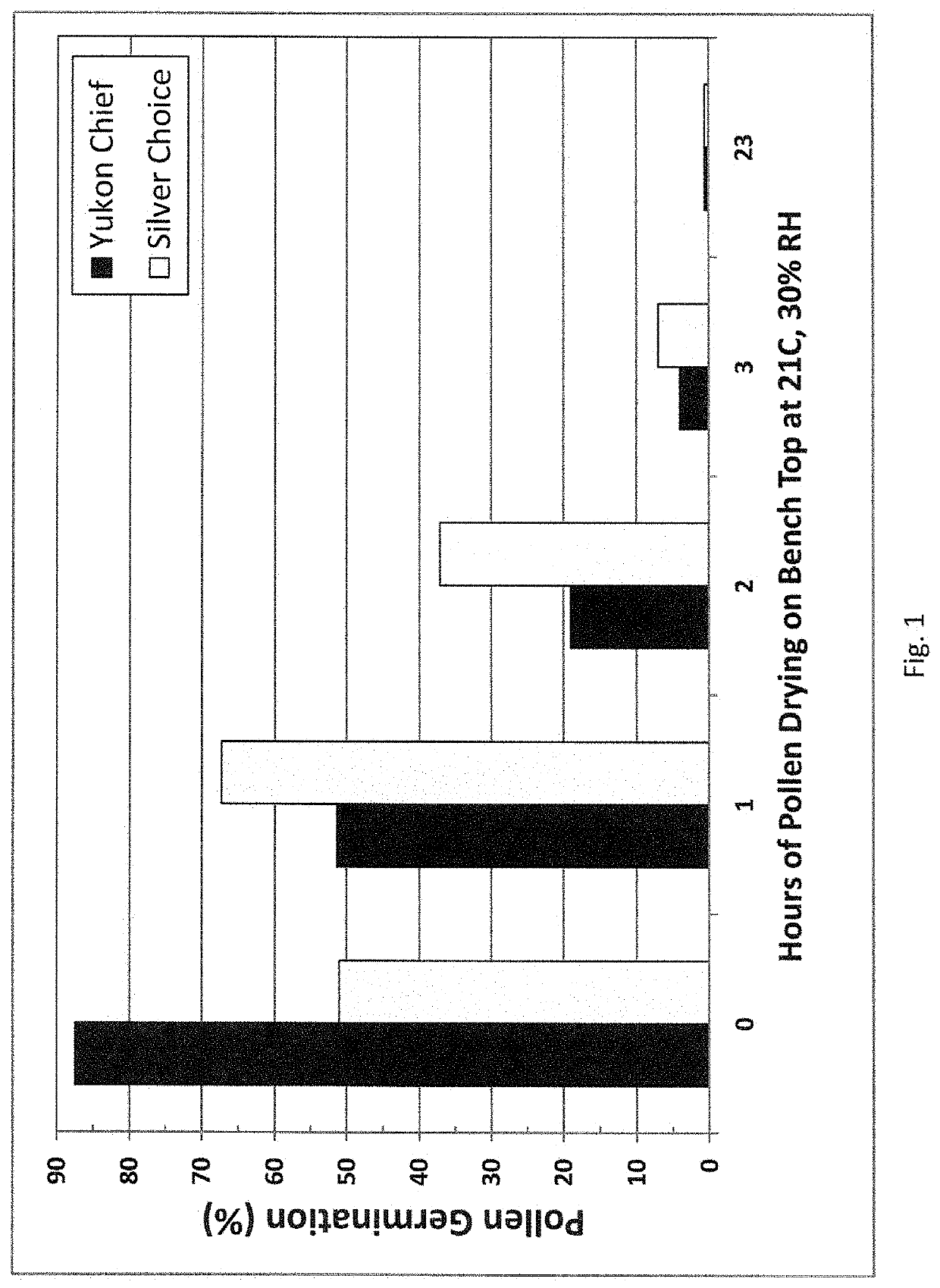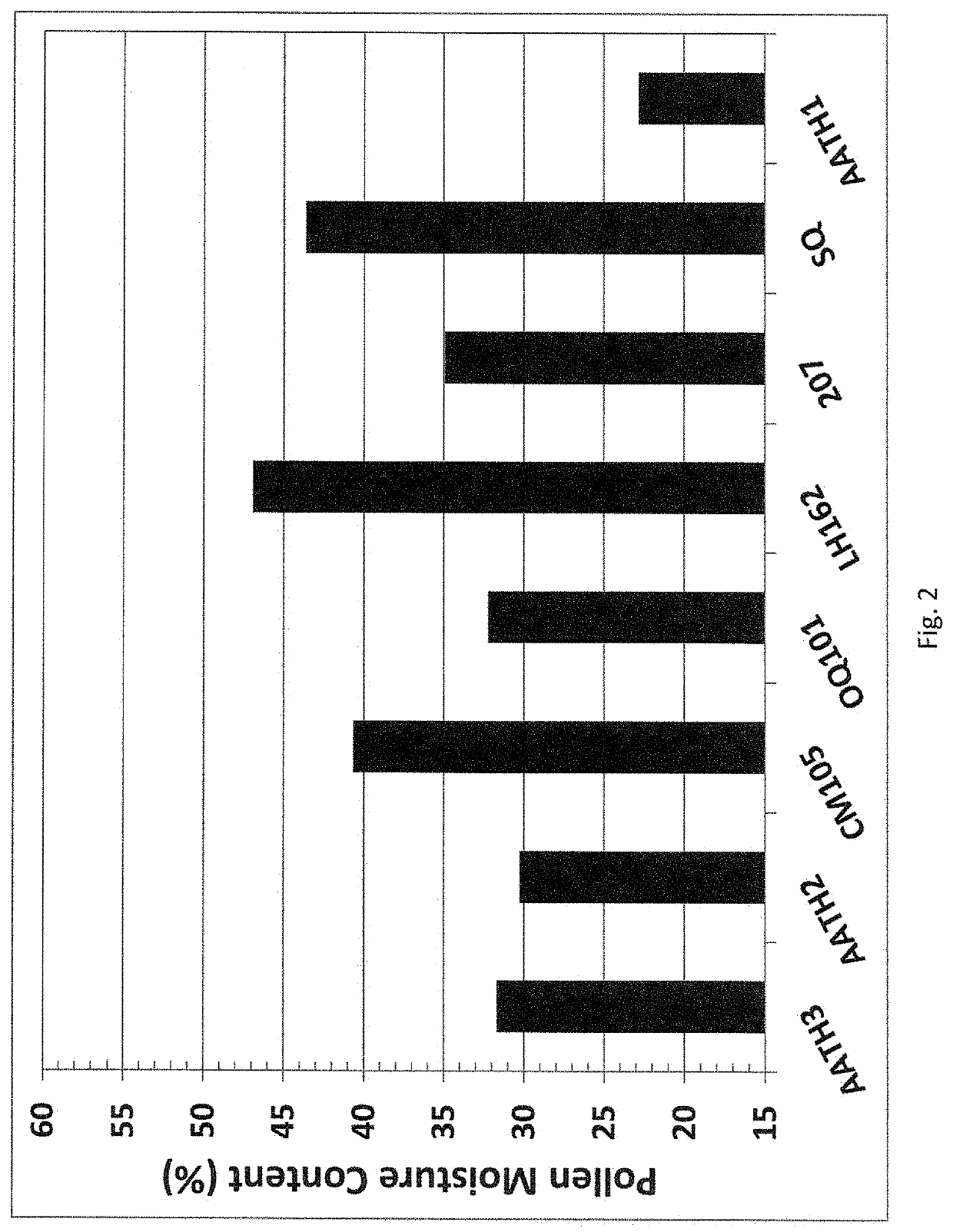Pollen field conditioning and preservation method
a technology of pollen field and conditioning method, which is applied in the field of pollen field conditioning and preservation method, can solve the problems of rapid loss of viability, affecting pollen viability and longevity, and exposure to dry air and high temperature, and achieves large differences in pollen tolerance and the effect of assessing viability
- Summary
- Abstract
- Description
- Claims
- Application Information
AI Technical Summary
Benefits of technology
Problems solved by technology
Method used
Image
Examples
example 1
[0090]A study was undertaken to determine the effect of plant genetic background on the viability and overall health of freshly-shed pollen. Fresh pollen was collected from field grown maize plants of eight genetic backgrounds in Grimes, Iowa at approximately 11:30 am on Aug. 14, 2016. The genetic backgrounds were selected to represent a broad sample of heterotic groups known in maize breeding. Tassels of the plants were vigorously brushed free of adhering anthers and pollen at 9:00 am the same day. Pollen from tassels of approximately 10 plants of each genetic background was collected into a separate paper bag. Pollen was separated from debris by passage through a screen (150 micron pore size) and immediately placed into field conditioning at 4° C. for 80 minutes. Field conditioning involved spreading a thin layer of pollen in the bottom of a 15 cm petri plate that had prechilled water-moistened blotter paper held in the upper half of the plate. Following f...
example 2
Laboratory Conditions on Pollen Health
[0093]A study was undertaken to determine the effect of ambient laboratory conditions on the viability of freshly-shed pollen. Fresh pollen was collected from tassels of plants grown in the greenhouse and exposed to ambient environmental conditions in the laboratory. Pollen was taken from two unrelated genetic backgrounds of maize, Yukon Chief and Silver Choice, to preclude drawing conclusions based on a sole genetic material. Immediately after collection, pollen was separated from debris by passage through a screen (150 micron pore size) and placed in a thin layer on a paper sheet set on the laboratory bench. The pollen was left in this condition without any special precautions to control the laboratory ambient temperature and relative humidity, which were 21-23° C. and 30-34%, respectively, over the course of the experiment. The pollen was mixed to obtain homogeneity and sampled for measurement of viability at 0, 1, 2, 3 and 23 hours after the...
example 3
eld Conditioning: Cold and High Relative Humidity
[0096]A study was undertaken to determine whether the viability of field-shed pollen could be improved to reverse the negative effects of dehydration caused by vapor pressure deficit stress.
[0097]Fresh pollen was collected from field grown maize plants of eight genetic backgrounds in Grimes, Iowa at approximately 1:45 pm on Aug. 10, 2016. The ambient temperature and relative humidity were 31.7° C. and 72%, respectively, during collection. The genetic backgrounds were selected to represent diverse heterotic groups known in maize breeding, and included hybrid and inbred lines. The time of collection, mid-afternoon, was chosen intentionally because the vapor pressure deficit is typically more unfavorable to pollen health when temperatures are elevated and relative humidity reduced, compared to times earlier in the day. Tassels of the plants were vigorously brushed free of loosely held anthers and pollen at 9:00 am the same day and each s...
PUM
 Login to View More
Login to View More Abstract
Description
Claims
Application Information
 Login to View More
Login to View More - R&D
- Intellectual Property
- Life Sciences
- Materials
- Tech Scout
- Unparalleled Data Quality
- Higher Quality Content
- 60% Fewer Hallucinations
Browse by: Latest US Patents, China's latest patents, Technical Efficacy Thesaurus, Application Domain, Technology Topic, Popular Technical Reports.
© 2025 PatSnap. All rights reserved.Legal|Privacy policy|Modern Slavery Act Transparency Statement|Sitemap|About US| Contact US: help@patsnap.com



